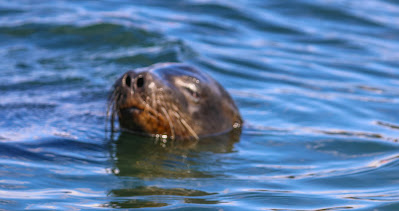The Galapagos sea lion is endemic to the Galapagos Islands and is the smallest species of sea lion. For quite a while it was considered a subspecies of the California sea lion, but genetic testing supported treating it as a separate species.
 |
| Showing its head at Elizabeth Bay while we were looking at marine iguanas, penguins and blue-footed boobies. |
Males have a thicker neck, chest and shoulders compared to their abdomen. The male also has a sagittal crest (a line running lengthwise along the skull) which creates a bump-like projection on the forehead at sexual maturity. Females have a longer, more slender neck and a thick torso and females and juveniles have a nearly flat head and little or no forehead.
 |
| They were everywhere at Espinoza Point on Fernandina Island. This very large male made huge noise as it paddled around in a pool surrounded by marine iguanas. Note the bump on the forehead. |
 |
| A mother nursing her pup got lots of attention. |
We saw them virtually everywhere. While we were waiting to be initially transported to our yacht by panga in Puerto Ayora, Santa Cruz Island, they were sleeping on nearly every bench at the dock. It was common to sea them while snorkeling, including a number of very close encounters.
 |
| We saw lots of sea lions along the shore of Santiago Island. |
 |
| As well as snorkeling. Note this big sea lion swimming between me and Judy (above back). |
They were popular with the passengers to the point where our guides would focus on them rather than other rarer sightings of birds, etc., to my chagrin. For example, we had only one sighting of a few nazca boobies near Vicente Roca Point, Isabela Island, and our guide immediately moved to a group of sea lions nearby and focused all of his attention on them, although we'd only looked at the boobies for 15 or 20 seconds.
They were fun, but they were everywhere.


















The sea lions were a wonderful surprise for me--so many sightings! I must confess that I enjoyed them more than the birds, which just sit there and don't do much. The sea lions play and swim and dive--lots of fun to watch!
ReplyDelete